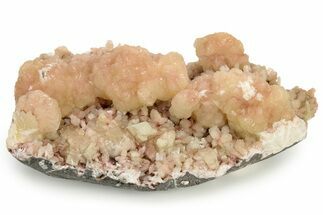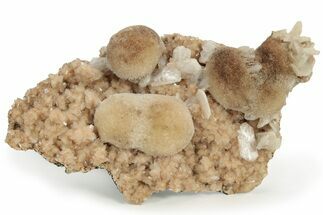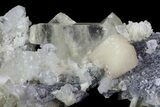This Specimen has been sold.
8.8" Stilbite, Apophyllite, Calcite and Quartz Association - India
This is an incredible 8.8" wide mineral association, containing stilbite, apophyllite, quartz druze and a beautiful, large calcite crystal. This was collected from Nashik in Maharashtra, India. The stilbite is translucent, with some faint pink coloration. Most of the apophyllite formed as double terminated crystals with brilliant luster and clarity. Quartz druze can be found surrounding all of the small stalactitic projections, and there is a massive, slightly yellow calcite crystal cluster in the center of the specimen. A truly wonderful specimen, perfect for any mineral collection.
Stilbite is probably the most common zeolite found in these deposits. Crystals often form flowery, bowtie or hourglass shaped structures and come in a variety of colors. Some of the most beautiful colorations are the pink or peach tints. Apophyllite while not a zeolite itself is almost always found associated with zeolites in the same pockets. It has two crystal habits, a rectangular prism capped by a steep four sided pyramid or a pseudo-cubic structure. While not a well known mineral to the general public it is popular among mineral collectors due to it's pastel colors and beautiful crystal formations.
Stilbite is probably the most common zeolite found in these deposits. Crystals often form flowery, bowtie or hourglass shaped structures and come in a variety of colors. Some of the most beautiful colorations are the pink or peach tints. Apophyllite while not a zeolite itself is almost always found associated with zeolites in the same pockets. It has two crystal habits, a rectangular prism capped by a steep four sided pyramid or a pseudo-cubic structure. While not a well known mineral to the general public it is popular among mineral collectors due to it's pastel colors and beautiful crystal formations.
About Calcite Crystals
Calcite crystals are a form of calcium carbonate (CaCO₃) known for their diverse shapes, transparency, and vibrant range of colors. They typically form in rhombohedral, scalenohedral, or prismatic shapes, often with well-defined, sharp edges and glossy surfaces. Calcite crystals are often translucent or transparent, sometimes displaying a double refraction effect where objects viewed through the crystal appear doubled. They can appear in various colors—white, clear, yellow, pink, blue, green, and orange—depending on impurities or trace minerals.
A notable characteristic of calcite is its reaction with weak acids like vinegar, which causes it to effervesce, or fizz, as it releases carbon dioxide. This property makes calcite crystals a key tool in geological identification and studies. Calcite forms in many environments, from sedimentary rocks like limestone and marble to hydrothermal veins.
Calcite crystals are a form of calcium carbonate (CaCO₃) known for their diverse shapes, transparency, and vibrant range of colors. They typically form in rhombohedral, scalenohedral, or prismatic shapes, often with well-defined, sharp edges and glossy surfaces. Calcite crystals are often translucent or transparent, sometimes displaying a double refraction effect where objects viewed through the crystal appear doubled. They can appear in various colors—white, clear, yellow, pink, blue, green, and orange—depending on impurities or trace minerals.
A notable characteristic of calcite is its reaction with weak acids like vinegar, which causes it to effervesce, or fizz, as it releases carbon dioxide. This property makes calcite crystals a key tool in geological identification and studies. Calcite forms in many environments, from sedimentary rocks like limestone and marble to hydrothermal veins.
About Quartz
Quartz is the name given to silicon dioxide (SiO2) and is the second most abundant mineral in the Earth's crust. Quartz crystals generally grow in silica-rich environments--usually igneous rocks or hydrothermal environments like geothermal waters--at temperatures between 100°C and 450°C, and usually under very high pressure. In either case, crystals will precipitate as temperatures cool, just as ice gradually forms when water freezes. Quartz veins are formed when open fissures are filled with hot water during the closing stages of mountain formation: these veins can be hundreds of millions of years old.
Quartz is the name given to silicon dioxide (SiO2) and is the second most abundant mineral in the Earth's crust. Quartz crystals generally grow in silica-rich environments--usually igneous rocks or hydrothermal environments like geothermal waters--at temperatures between 100°C and 450°C, and usually under very high pressure. In either case, crystals will precipitate as temperatures cool, just as ice gradually forms when water freezes. Quartz veins are formed when open fissures are filled with hot water during the closing stages of mountain formation: these veins can be hundreds of millions of years old.
SPECIES
Stilbite, Apophyllite, Calcite & Quartz
LOCATION
Nashik, Maharashtra, India
SIZE
8.8" wide, 6" deep, 2.1" tall
CATEGORY
ITEM
#65718
 Reviews
Reviews


















